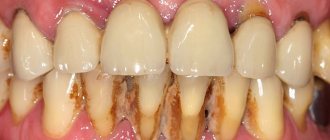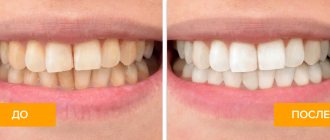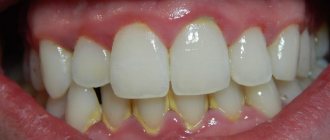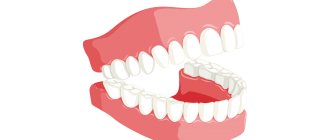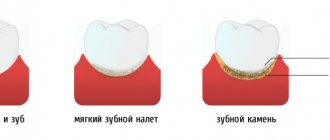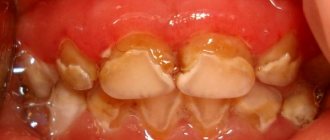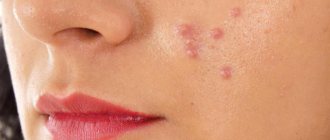Tartar on baby teeth can occur due to too soft food that the baby eats and insufficiently thorough oral hygiene. Unfortunately, children of all ages, from 1.5 years to 3-5 years and older, can also experience this problem. Are there any features to prevent the appearance and elimination of tartar on baby teeth?
Tartar in children - features of dental plaque removal in childhood
If the primary plaque on enamel is easily removed with an ordinary brush and paste, then with tartar things are much more complicated. Hardened deposits can only be removed by a dentist. Using special devices, the doctor carefully cleans the surface of the teeth from plaque, and also removes supra- and subgingival deposits, which most often cause the development of inflammatory processes in periodontal tissues. Read more about the specifics of removing tartar in children in our article.
Causes of plaque
Tartar in most cases occurs under the influence of local factors. Some of the most striking reasons for the formation of plaque in children include non-compliance with oral hygiene rules and a lack of solid foods in the daily diet. In addition, the cause of plaque in large quantities may be the absence or deficiency of pyrophosphate in the baby’s saliva. This substance can slow down the development of various types of deposits on teeth. The appearance of tartar may also indicate an insufficient amount of a particular protein in the saliva of a small patient that can inhibit the growth of crystalline deposits.
It is not always possible to recognize the presence of tartar on a child’s teeth. This is explained by the fact that the surface of the tooth enamel and the calcium phosphate crystals are closely connected, and this, in turn, complicates the recognition of the boundary between the beginning of the tartar and the end of the enamel.
Types of tartar
In dentistry, there are only two types of tartar, which are recognized by their location on the teeth:
- supragingival
- subgingival.
Supragingival tartar is usually gray or white-yellow in color. It can be seen with the naked eye and can be easily removed by scraping. The formation of supragingival tartar occurs due to the deposition of minerals that come from saliva. In most cases, the localization of this type of stone is in the areas of the frontal teeth of the lower jaw and upper molars (buccal surfaces), where the ducts of the glands that form saliva are located.
Regarding subgingival tartar, it is more difficult to recognize. Only a dentist can do this with probing. Subgingival tartar is formed due to mineral deposits, which come mainly from the gingival fluid. Places of its localization: tooth neck, root cement, periodontal pocket. In most cases, plaque is firmly attached to the tooth surface, covering the neck and forming protrusions. Subgingival stone is dark brown and has a greenish tint.
A child has tartar – what to do?
If you have discovered tartar on your child’s teeth, then first of all, make an appointment with a pediatric dentist. Tartar removal will be performed in two steps. At the first appointment, the little patient will have a professional teeth cleaning. With its help, soft plaque and deposits on the teeth will be removed. Subgingival tartar is removed under local anesthesia using ultrasound. As a rule, after such procedures, the pediatric dentist explains to the little patient how to properly brush his teeth and care for the oral cavity, and asks his parents to supervise the procedures. The second appointment is scheduled a couple of weeks later. At the second visit to a specialist, the thoroughness of the previously removed tartar and deposits is monitored.
Tartar in children: prevention
Among the reasons listed above for the formation of tartar, the absence of pyrophosphate in the child’s saliva was noted. And to prevent the formation of plaque on your teeth, you can use special toothpastes that contain this component. This will help not only stop the process of mineralization of stone on the teeth, but also prevent the growth of a new layer. Thus, the pyrophosphate contained in the paste, in some way, replaces the natural analogue if it is not present in the child’s saliva. However, when choosing a toothpaste with this component, be sure to take into account the appropriate age category.
The toothbrush plays an important role in the formation of tartar. Choosing the right toothbrush for your child will help prevent new growths. When choosing a brush to clean children's teeth, it is necessary to give preference to artificial bristles, since bacteria and microorganisms can form in natural bristles. At the same time, do not forget that experts recommend changing brushes once every 3 months, at least.
To prevent the formation of tartar in the youngest patients who cannot yet brush their teeth on their own, you can use special wipes. They contain xylitol, which can inhibit the development of bacteria in the oral cavity. By wiping the surface of your child’s teeth with these napkins, you can also clean them of soft plaque.
In order to maintain proper oral hygiene, it is necessary to teach your child the basic rules. According to the basic recommendations of pediatric dentists, you should first brush the teeth of the upper jaw with brush movements from top to bottom, starting in the lateral sections and smoothly moving to the front. In the same sequence, it is necessary to manipulate the toothbrush when brushing the lower teeth, moving it from bottom to top. At the same time, do not forget to pay attention to the hygiene of the mucous membranes of the tongue, cheeks, and palate, because bacteria can form on them too.
Among other things, it is worth diversifying the children's menu by adding more solid foods to it. An excellent option would be fresh carrots, apples, cabbage and others.
Note to parents
Parents should regularly monitor their child’s oral hygiene. To prevent the formation of tartar, it is worth taking your child to the pediatric dentist. This will allow pathology to be detected in time so that it does not cause the development of diseases (periodontitis, gingivitis, stomatitis, etc.) in the child’s oral cavity. In addition, the child will not have problems associated with bad breath. Visits to the dentist will allow you to timely provide the necessary care to your teeth with braces installed on them.
And remember that only a pediatric dentist who uses an individual approach and a special set of professional tools and products can remove tartar and mineralized plaque.
Tags: Cleaning
Why does tartar appear in childhood?
Plaque can appear in children under 3 years of age. It usually occurs in the cervical area and in the spaces between the teeth - it is in these hard-to-reach places that food particles most often remain. Plaque on the visible side of the teeth often appears against the background of progressive periodontitis or gingivitis. If you don't brush your teeth for at least two days, plaque will begin to harden and gradually transform into tartar.
Plaque can turn into tartar
Important! Plaque contains pathogenic microbes, which, in turn, help food debris decompose faster. As a result, there is a gradual destruction of the enamel, which serves as a protective barrier for dentin and pulp.
Recognized experts in the field of pediatric dentistry claim that the occurrence of stone on baby teeth in a child aged 1.5-2 years and older is a consequence of the influence of local factors. The main problem is poor oral hygiene. In addition, a lack of solid foods in the diet can also affect the condition of the teeth. The formation of stone is directly related to the process of accumulation of calcium and protein salts that are present in saliva. The situation is aggravated by the rapid proliferation of harmful bacteria, which children's saliva, due to its composition, cannot resist.
Thus, among the main factors explaining why children develop tartar, the following circumstances are distinguished:
- low level of oral hygiene,
- lack of solid vegetables and fruits in the daily diet,
- bad habit of chewing food on one side of the jaw,
- defects of the dental system, in which dental deposits form in places that are difficult to reach for cleaning,
- taking powerful antibacterial drugs,
- diseases associated with the gastrointestinal tract.
Reasons why tartar forms
Local factors play a major role in the formation of tartar. For starters, this is poor oral hygiene in childhood. In addition, the cause of tartar is an insufficient intake of solid foods. Also, tartar in large quantities occurs as a result of the lack of pyrophosphate in saliva - a substance that retards the development of dental plaque and the lack of protein in it, which tends to slow down the growth of crystals. Tartar on children's teeth is not always obvious. Calcium phosphate crystals can bind tightly to the surface of the enamel, making it often difficult for the dentist to determine where the stone begins and the enamel ends.
Main types of tartar
Currently, dentists distinguish two main types of tartar - supra- and subgingival. The first one can be seen independently; it usually has a grayish or yellowish tint. As a rule, such a stone is successfully removed by scraping. More often it forms in the area of the lower front teeth, as well as on the surface of the molars of the upper jaw.
Subgingival calculus can only be identified by a professional dentist. Its formation is associated with the process of accumulation of minerals, the main source of which is gingival fluid. This stone is usually dark brown in color with a slight greenish tint. Its localization occurs on the neck of the tooth, that is, deposits do not extend beyond the boundaries of the gingival margin, as well as on periodontal pockets1. The stone literally encircles the neck of the tooth, as shown in the photo below.
This is what dental plaque looks like on a child
Prevention measures
- As noted above, the absence of a substance such as pyrophosphate can lead to the formation of tartar. Therefore, some toothpastes contain this component. It stops the mineralization of tartar and prevents the process of new growth. The addition of pyrophosphate to toothpastes to some extent compensates for the lack of a natural analogue in saliva. When choosing a paste with this substance, pay attention to what age children it is recommended for.
- A properly selected children's toothbrush will also help prevent the appearance of tartar in children. It is best to prefer a brush with artificial bristles, since, unlike natural bristles, microorganisms do not form in it. Naturally, you need to remember that you should change your toothbrush every three months. In the meantime, until your child reaches the age when he can brush his teeth on his own, you can use special napkins to clean his teeth. They contain xylitol, which inhibits the growth of bacteria on teeth and gums and cleanses them well of soft plaque. Also relevant in this case are fresh hard fruits and vegetables: apples, carrots, cabbage.
- In order for oral hygiene to be as effective as possible, it is very important to teach your child how to brush their teeth properly. Among the main recommendations of dentists, we highlight the following: first, we clean the upper jaw from the outside and inside, starting from the sides, then the front teeth from top to bottom. On the lower jaw the sequence is the same, only the brush moves from bottom to top. Do not forget about the hygiene of the mucous membranes of the cheeks, palate and tongue, where a large number of bacteria are formed.
- Parents need to monitor their children's oral hygiene and regularly take them to the pediatric dentist. This will help prevent the formation of tartar, which can cause various oral diseases, for example, gingivitis in children, childhood periodontitis, and various types of stomatitis in children. In addition, your child's bad breath will also not bother you. Teeth with children's braces will need special care. Remember that food debris and soft plaque can be easily removed with a toothbrush and toothpaste. Removal of mineralized dental deposits is carried out only by a hygienist using special means and instruments.
What could be the consequences?
If measures are not taken in a timely manner to remove the stone, it can provoke a lot of serious consequences for the condition of the oral cavity and the entire body as a whole. Thus, dental deposits can lead to the development of caries, gingivitis, periodontitis and periodontal disease. Inflammatory processes in soft tissues are usually accompanied by bleeding, exposure of roots and the appearance of swelling. As a result, the patient may encounter the following problems:
- dental diseases associated with the condition of the mucous membrane,
- inflammatory processes in the gums,
- carious lesions: from caries to pulpitis and periodontitis,
- halitosis – the appearance of an unpleasant odor from the mouth,
- exacerbation of general diseases of the body - diabetes mellitus, disorders of the cardiovascular system, malfunction of the ENT organs and the immune system, and others,
- general deterioration in well-being and health of the entire body as a whole.
Caries in a child can cause tartar.
But the most dangerous problem can be the premature loss of a baby tooth, which will ultimately negatively affect the formation of a permanent bite, especially if parents do not pay due attention to prosthetics of the lost element of the smile. Yes, even small children need this procedure if necessary.
How to prevent it?
The main task of parents is not to cure the disease, but to prevent it! Therefore, certain measures should be taken to prevent mineral deposits on teeth:
- As soon as the first teeth appear, you need to teach the child to eat solid food, do not follow the lead of the little lazy person - do not chop carrots and apples;
- You should brush your teeth with a children’s brush, which is better to buy on the recommendation of a dentist;
- You need to change the brush every 2-3 months;
- Teach your child to brush their teeth correctly. The doctor will give you all the necessary recommendations at your appointment.
- purchase pastes with pyrophosphate (but strictly in accordance with the age of the baby).
But the most important rule is to bring your child once every six months for a dental examination. This will not only help get rid of tartar, but also prevent serious diseases in the future that are caused by mineral deposits: periodontitis, gingivitis, stomatitis.
Tartar removal: how the procedure is performed
Professional oral hygiene cannot be performed if your baby has stomatitis or an acute infectious disease. Also, the procedure is contraindicated in case of enamel hypoplasia and if the baby is prone to allergic reactions to the components of the drugs.
How to remove tartar from a one-year-old child? The first thing you should do is visit your pediatric dentist. During the first visit, the doctor will conduct a thorough visual examination of the little patient’s oral cavity and prescribe professional cleaning.
This procedure involves removing plaque, as well as removing supra- and subgingival deposits using a special paste and brush. If the enamel and gums are hypersensitive, children will numb the affected area with local anesthetics such as sprays. If we are talking about a child 5-7 years old, then additional pain relief may not be needed at all.
“My daughter is only 4.5 years old, but she already has tartar! Not a plaque, but a stone! At the same time, I personally brush her teeth twice every day - in the morning and in the evening. No one gave me a clear reason; they associated it with taking antibiotics, which we had to take when our daughter was still an infant. As a result, cleaning had to be done. I was very worried how the child would react, but she didn’t even squeak once. They gave her some light freezing, and everything went great. Just in case, I added more solid fruits and vegetables to my diet - this is the best natural teeth cleaning.”
Galina, Moscow, from correspondence on a thematic forum
The photo shows a professional cleaning of a child's teeth.
After removing plaque, the doctor coats the enamel with a special fluoride-containing compound and gives recommendations to parents on how to properly brush their child's teeth and monitor oral care. You will have to visit the specialist again a few weeks after the procedure. At the appointment, the doctor will be able to assess the quality and effectiveness of the previously performed procedure.
Pay attention to the fact that professional hygiene has some differences between adults and children. An ultrasonic scaler is used for adults, while for children under 14 years of age its use is not entirely justified and is even contraindicated. This can cause harm, such as damage to the growth zone of the teeth or damage to the structure of the child’s fragile enamel, which subsequently negatively affects both the primary and permanent dentition.
What to do if a child has tartar?
If you discover tartar in your child, first be sure to make an appointment with a pediatric dentist. At the first visit, the little patient undergoes professional teeth cleaning: dental plaque and soft plaque are removed. Subgingival stone is removed under local anesthesia using ultrasound. After the procedure, the dentist tells parents about the need to monitor whether the child is brushing their teeth correctly. Before and after the procedure, the hygiene index is checked and the oral care rules are repeated in the presence of parents. After 1-2 weeks, an appointment is made to monitor the thoroughness of dental plaque removal
Preventive actions
What to do to prevent your child from developing tartar? The answer to this question lies in prevention, the essence of which comes down to following important recommendations:
- choosing a suitable brush and paste for daily brushing of teeth: it is advisable to change the toothbrush once every three months,
- using special wipes to additionally remove plaque and food debris from the mouth - such products can be used from a very early age, even if the child is only 1 year old. Such napkins allow you to maintain baby’s oral hygiene when he does not yet know how to brush his teeth,
- the presence of a sufficient amount of solid foods in the diet,
- control over how responsibly the child approaches daily hygiene procedures,
- Regular visits to the dentist for preventive examinations and timely detection of possible diseases.
Teach Children Good Oral Hygiene
Tartar may not seem like a serious problem that requires immediate action. However, it is dental plaque that in most cases causes the development of serious inflammatory dental diseases and ultimately leads to the loss of living teeth. For this reason, it is extremely important to take a responsible approach to regular visits to the dentist and strictly ensure that the child maintains the proper level of oral hygiene.
- Epidemiology, prevention and treatment of major dental diseases in children: material, scientific and practical. Conf.: RIC TGMA, 2004.
Provoking factors
The main reason why tartar forms in young children is poor oral hygiene. Even parents are not always able to thoroughly clean children’s teeth, so, as a rule, large plaque accumulates in hard-to-reach places.
The provoking factor may be:
- lack of solid food in the child’s daily diet;
- bite pathologies;
- long-term use of antibiotics;
- gastrointestinal diseases.
It is not always possible to eliminate the provoking causes of tartar in a child, so dentists recommend that parents constantly monitor the quality of their teeth cleaning.
Treatment methods
It is not possible to treat tartar on your own. Tartar removal is performed using practical and painless methods in the dentist’s office:
- Ultrasonic cleaning. This is the treatment of tartar with a scaler. The equipment generates low-frequency ultrasonic vibrations that destroy dental plaque. After this, the dentition is washed with a stream of water, and the enamel is ground and polished.
- Air Flow whitening system. In this case, cleaning is performed with an abrasive compound supplied under pressure through a special nozzle. The composition includes air, water and sodium carbonate. The equipment does an excellent job of cleaning the interdental space and effectively removes stubborn plaque.
- Laser cleaning. This is a non-contact technique that does not cause discomfort or pain. Tartar cleaning is performed with a directed laser beam, the remaining particles are washed out of the oral cavity with a water-air jet.
Kinds
Soft plaque or so-called dental plaque is a formation that over time turns into tartar. This deposit consists of microbes and their metabolic products, tightly fixed on the surface of the tooth.
As a result of the vital activity of microorganisms, an acidified environment is formed inside the dental plaque. Human saliva has bactericidal properties, however, in this case, it simply cannot overcome the dense barrier of dental plaque and neutralize the acidic environment formed inside.
Dental plaque is denser than normal plaque that forms throughout the day and cannot be removed by regular tooth brushing.
Bacteria, their metabolic products, food debris and mucus are compressed into a dense mass, and, saturated with the mineral components of saliva, turn into solid deposits - tartar.
There are two types of tartar: supragingival and subgingival. If the first type, which is a dark edging over the gum, is visible to the naked eye during a visual examination, then the dentist can detect the second type only with the help of a special probe.
Since the minerals for the formation of supragingival calculus come from saliva, it is also called salivary calculus. Similarly, subgingival tartar is called serum tartar, since its mineralization occurs due to gingival fluid, similar to blood serum.
Reference! It should be noted that subgingival calculus does not form on the milk teeth of young children.
